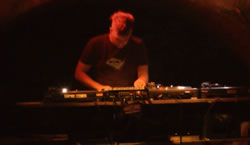Copyriot
The 20th century was the century of sound recording media. Before Edison and Berliner, there was no way to store sound, but nowadays it can be stored on any digital carrier — there is no longer any need for records, CDs, tapes or the like. Writing a history of turntable music and its political implications would probably include the stories of Charles Cros, Robert Moses, the Detroit automobile industry and various patent wars, but here is a short summary.
The record player was the first universal sampler (if we leave out the human voice as a method of reproducing sounds) that was able to reproduce any given audible event. In the 1920s, record players were a cutting-edge technology and Dada artists and Futurists, as well as composers such as Stefan Wolpe (who was also influenced by the Dadaists) and Ottorino Respighi used it in concerts and performances; certainly for the Dadaists and Futurists it was a means of provocation and subversion to promote their ideas. In 1939, at the dawn of World War II, John Cage used record players as his vehicles to migrate into Imaginary Landscape No. 1, and after the war musique concrète brought an entirely new way of thinking into music and its relation to (recorded) sound, while writers like Brion Gysin and William S. Burroughs developed very similar techniques for written text. In the early 1970s, when it became clear that counterculture would not lead the Western society into a bright future, some kids in the South Bronx took record players and started hip hop to express their frustrations, hopes and will to party hard. Thanks to DJ Kool Herc, Africa Bambaataa and Grandmaster Flash, the record player had finally become a widely accepted instrument. A few years later Swiss-American art student Christian Marclay combined influences from rock music, Fluxus and hip hop, and became the (grand-)father of contemporary avant-garde turntablism. At that time DJs became the new guitar players, the coolest boys and (occasionally) girls on stage. Techno culture popped up towards the end of the much-loved good/bad dichotomy of the Cold-War era and gave DJing another push in popularity. Samplers became affordable and Negativland helped popularize U2, defining the basics of plunderphonics along their way.

In the last years of the past century, experimental turntablism had a creative peak, bringing together a wide range of influences from various music and art forms, mirroring the chaotic, postmodern power vacuum of the flipping political magnets in Eastern Europe and the reorganization of Western societies towards total consumer capitalism. During those years, when vinyl as a playback medium seemed destined to be replaced by CDs, a generation of experimental turntablists like Otomo Yoshihide, Martin Tétreault and, a bit later, Marina Rosenfeld and eRikm appeared in public. This was also the time, when I did my first public attempts to wrestle vinyl grooves. Now, another 20 years and roughly two generations of turntablists later and almost exactly a hundred years after the first Dadaistic record player performances, “analogue” and “digital” are no longer seen as contradictory philosophies. Female turntablists are also not as rare as they used to be, and record players, surprisingly outliving their expected obsolescence, have become a well received and accepted instrument in many fields of music.
Like many others of my generation, I inhaled the promises of individual freedom, rebellion and independence that came with punk culture and later also (re-)discovered subversive practices in earlier art forms like Fluxus and Dada. Turntablism is a practice of meta-music. Turning turntables into instruments meant turning existing music into snippets of cultural information carriers and consequently rearranging (sub-)culture itself. This is the aspect of turntable music that provoked my interest, more than DJing (as in dance music) or experimentation for its own sake.
Adopting turntables as my main instrument, along with my second instrumental passion, computers, allowed me to scrutinize and abuse existing musical forms as vehicles of infiltration and subversion. The promises of collage, mash-up, plunderphonics were endless and opened new worlds to me. From the beginning I worked mostly improvised on stage, since this allowed me to deliver the experience of colliding musical particles as freshly and directly as possible to the audience, and at the same time forced me to react in real time to the results, thus creating an entangled state of possible failure and hoped-for success. In other words: the tension of experiments without a safety net.


While economic parameters have always shaped cultural phenomena, at present, music business dominates music creation more than ever and attention has become the main indicator for success. It has become a currency more valuable than emotions or identification, which were important parameters in earlier decades. Attention seems to be the most effective way to sell music. This paradigm shift started gradually after the innovative peak of (Western) industrial societies in the second half of the 20th century and accelerated after capitalism lost its communist counterpart and became the unquestioned blueprint for every individual and their activities.
Formerly subversive practices like irony and provocation have become regular marketing instruments, continuously rendering concepts like “statements” and “ideals” pointlessly old-fashioned, thus making a distinction between subversion and conformity harder, if not irrelevant. These mechanisms are most visible in popular culture, but active in any public field. It’s of no use to discuss the feminist implications of a music video showing a female singer, riding a wrecking ball, when this image has only one intended purpose: generate broadest possible attention and consequently: generate money for those who planted the image: what could have been a provocative feminist statement from a riot grrrl band in the 1990s is yet another marketing statement in the 2010s. Unruliness has become a medium to create contrast and separate music into market segments, also known as “styles” — pretty gardens walled by copyright. Even what we thought was chaos turned out to be fractal ramifications of economic power and what was formerly known as individuality has become a narcissistic necessity of salesmen and consumers. The self turns out to be the æsthetic battlefield of contemporary economy.


What else should a die-hard turntablist like me do in such a situation, if not restart from scratch and sample those aspects of universal profit maximization in search for a loophole. Let the wrecking ball softly wreck the wrecking company! It’s the same setup as before: vinyl, record players, digital or analogue effects and certainly a mixer. Also the techniques have not changed very much: re-purposing as a way to find and establish new perspectives. Recombination of existing material to uncover hidden commonalities, potentials and restrictions. It can even be the same records as before, but the question has become a different one: “Is there any escape from self?”
A more technical thing that has changed my approach to turntable music a lot in the last few years was the acquisition of a vinyl recorder. Being able to cut my own records allowed me to investigate any sound I wanted I wanted, even my own music. Thus, it became possible to keep the feedback of music creation in a much more stable state. This also caused a shift in my performances. Away from more physical and mechanical techniques around the record players, back to a focus on the actual content of the groove.
This is how my quest has changed over the years, how my perspective has shifted from rebellion to short-circuiting, from noise to distortion, from screaming to giggling. Not because I became bored with ferocity, but because ferocity is the new conformity, which is still the thing to overcome.
Social top